1993 CHEVROLET CAVALIER traction control
[x] Cancel search: traction controlPage 76 of 308
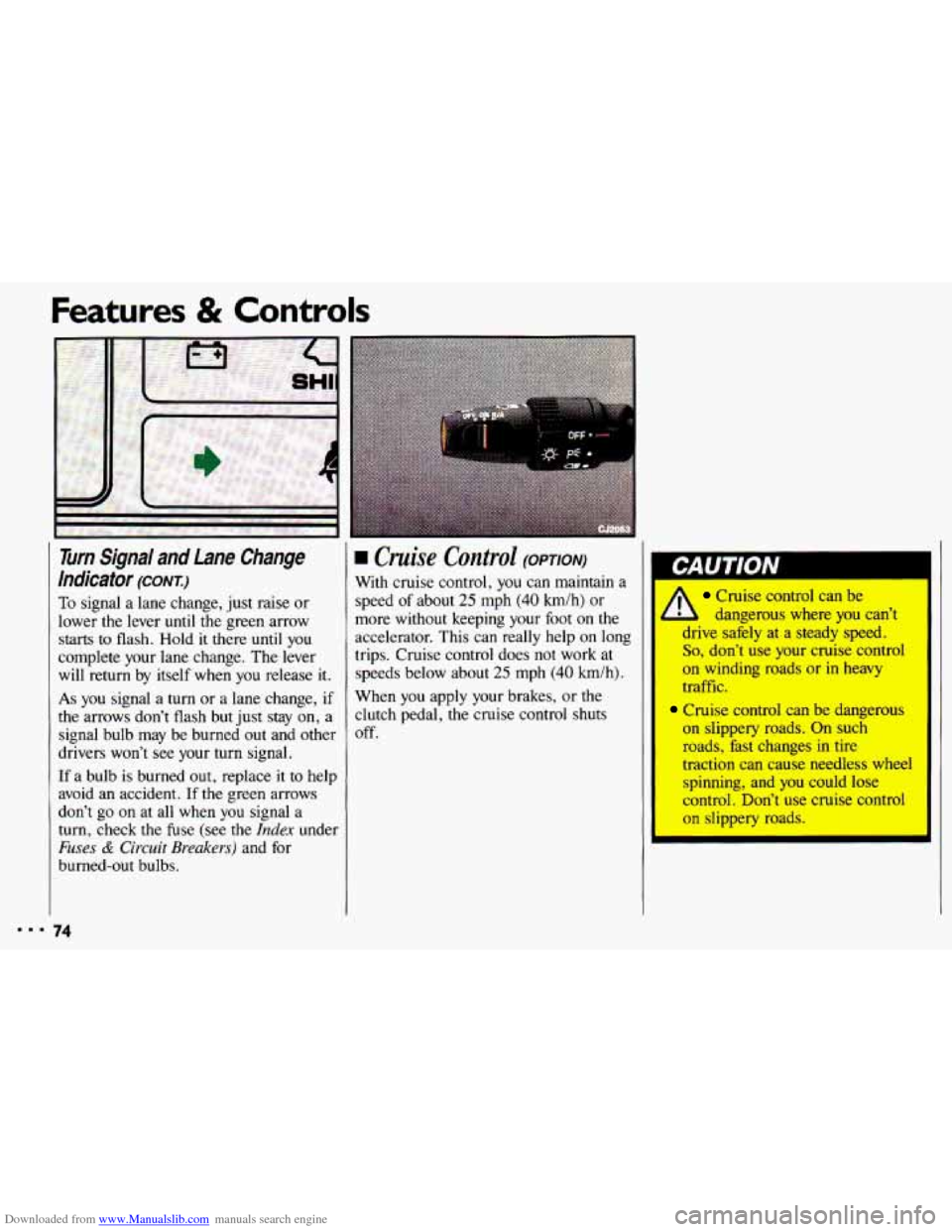
Downloaded from www.Manualslib.com manuals search engine Features & Controls
Turn Signal and Lane Change
Indicator
(CONI)
To signal a lane change, just raise or
lower the lever
until the green arrow
starts to flash. Hold it there until you
complete your lane change. The lever
will return by itself when you release it.
As you signal a turn or a lane change, if
the arrows don’t flash but just stay on, a
signal bulb may be burned out and other
drivers won’t see your turn signal.
If a bulb is burned out, replace it to help
avoid an accident.
If the green arrows
don’t go
on at all when you signal a
turn, check the fuse (see
the Index under
Fuses & Circuit Breakers) and for
burned-out bulbs.
74
rn Cruise Control (OPTION)
With cruise control, you can maintain a
speed of about
25 mph (40 h/h) or
more without keeping your foot on the
accelerator. This can really help on long
trips. Cruise control does not work at
speeds below about
25 mph (40 km/h).
When you apply your brakes, or the
clutch pedal, the cruise control shuts
off.
Cruise control can be
l dangerous where you can’t
drive safely at a steady speed.
So, don’t use your cruise control
on winding roads or-in heavy
traffic.
Cruise control can be dangerous
on slippery roads. On such
roads, hst changes in
tire
traction can cause needless wheel
spinning, and you could
lose
control. Don’t use cruise control
on slippery roads.
Page 140 of 308
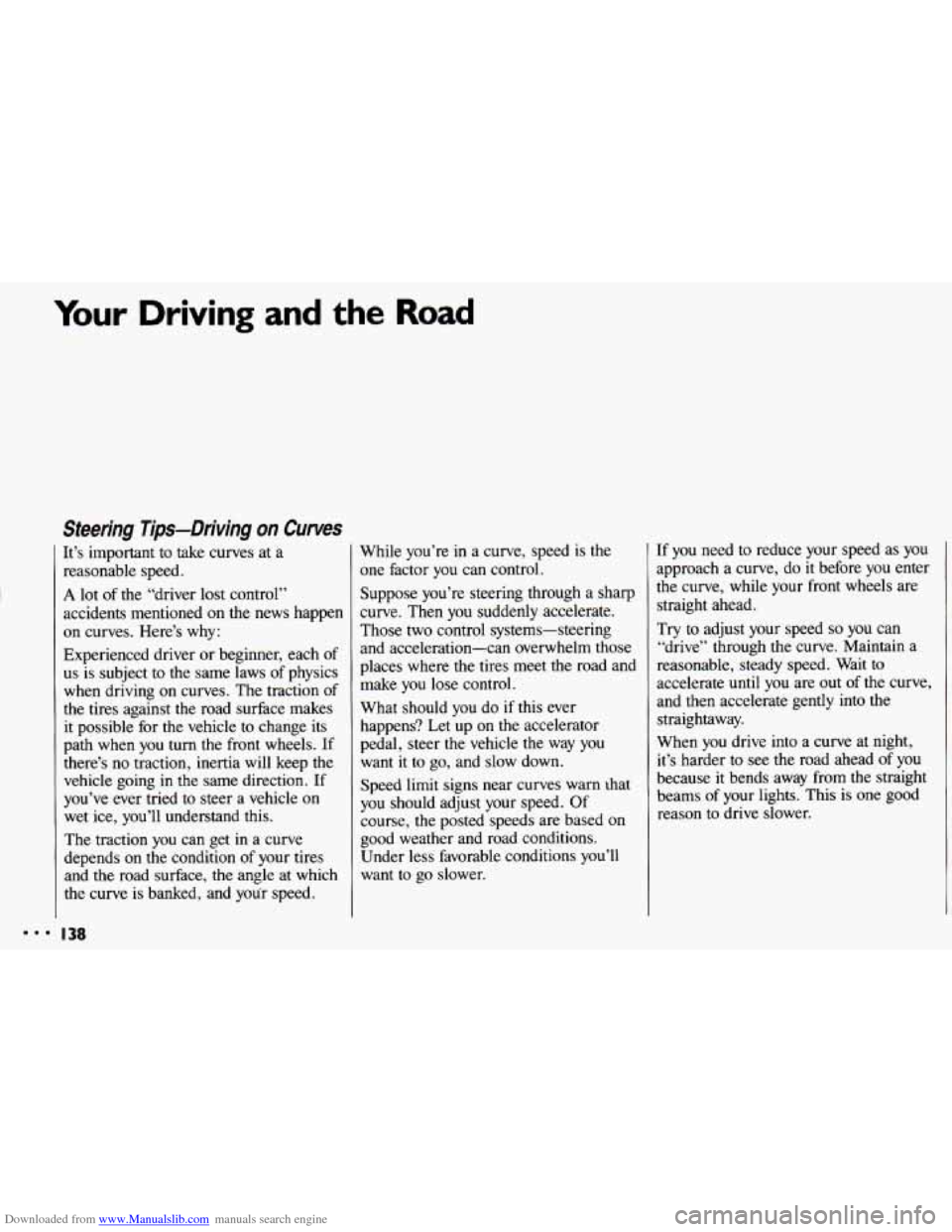
Downloaded from www.Manualslib.com manuals search engine ..I
Your Driving and the Road
Steering Tips-Driving on Curves
It’s important to take curves at a
reasonable speed.
A lot of the “driver lost control”
accidents mentioned on the news happen
on curves. Here’s why:
Experienced driver or beginner, each of
us is subject to the same laws of physics
when driving on curves. The traction of
the tires against the road surface makes
it possible for the vehicle to change its
path when you turn the front wheels.
If
there’s no traction, inertia will keep the
vehicle going in the same direction. If
you’ve ever tried to steer a vehicle on
wet ice, you’ll understand this.
The traction
you can get in a curve
depends on the condition
of your tires
and the road surface, the angle at which
the curve is banked, and youT speed.
I38
While you’re in a curve, speed is the
one factor you can control.
Suppose you’re steering through
a sharp
curve. Then you suddenly accelerate.
Those two control systems-steering
and acceleration-can overwhelm those
places where the tires meet
the road and
make
you lose control.
What should you do if this ever
happens? Let up
on the accelerator
pedal, steer the vehicle the way
you
want it to go, and slow down.
Speed limit signs near curves warn lhat
you should adjust your speed.
Of
course, the posted speeds are based on
good weather and road conditions.
Under less favorable conditions you’ll
want to go slower. If
you need to reduce your speed
as you
approach a curve, do it before you enter
the curve, while your front wheels are
straight ahead.
Try
to adjust your speed so you can
“drive” through the curve. Maintain a
reasonable, steady speed. Wait to
accelerate until
you are out of the curve,
and then accelerate gently into the
straightaway.
When
you drive into a curve at night,
it’s harder
to see the road ahead of you
because
it bends away from the straight
beams
of your lights. This is one good
reason
to drive slower.
Page 144 of 308
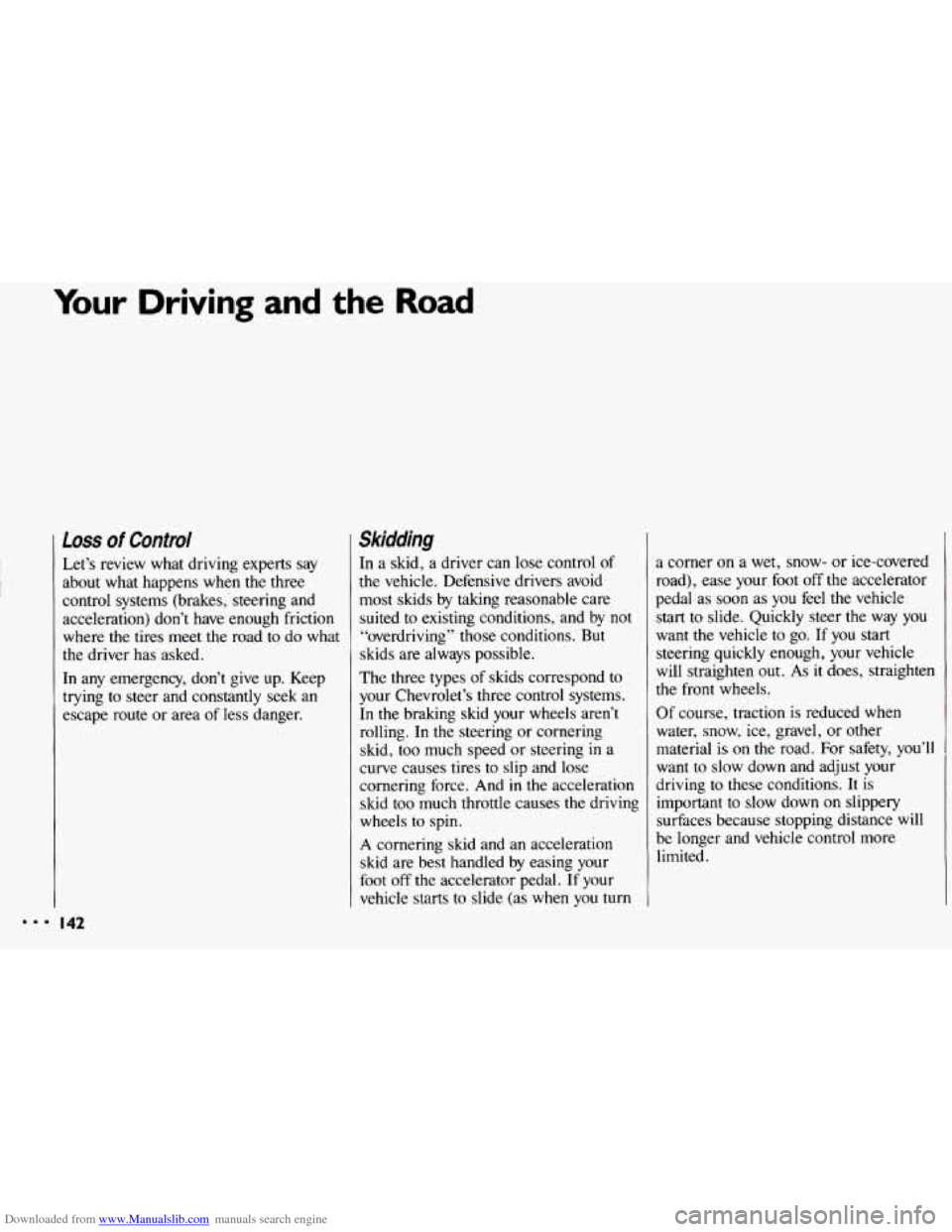
Downloaded from www.Manualslib.com manuals search engine Your Driving and the Road
Loss of Control
Let’s review what driving experts say
about what happens when the three
control systems (brakes,‘ steering and
acceleration) don’t have enough friction
where the tires meet
the road to do what
the driver has asked.
In any emergency, don’t give up. Keep
trying
to steer and constantly seek an
escape route or area of less danger.
I42
Skidding
In a skid, a driver can lose control of
the vehicle. Defensive drivers avoid
most skids
by taking reasonable care
suited
to existing conditions, and by not
“overdriving” those conditions.
But
skids are always possible.
The three types of skids correspond
to
your Chevrolet’s three control systems.
In the braking skid your wheels aren’t
rolling. In the steering
or cornering
skid, too much speed or steering
in a
curve causes tires to slip and lose
cornering force. And
in the acceleration
skid too much throttle causes the driving
wheels
to spin.
A cornering skid and an acceleration
skid are best handled by easing your
foot off the accelerator pedal. If your
vehicle starts
to slide (as when you turn
a corner on a wet, snow- or ice-covered
road), ease your foot off the accelerator
pedal as soon
as you feel the vehicle
start to slide. Quickly steer the way you
want the vehicle to
go. If you start
steering quickly enough, your vehicle
will straighten out. As
it does, straighten
the front wheels.
Of course, traction is reduced when
water, snow, ice, gravel, or other
material is
on the road. For safety, you’ll
want to
slow down and adjust your
driving to these conditions. It is
important to slow down on slippery
surfaces because stopping distance
will
be longer and vehicle control more
limited.
Page 234 of 308
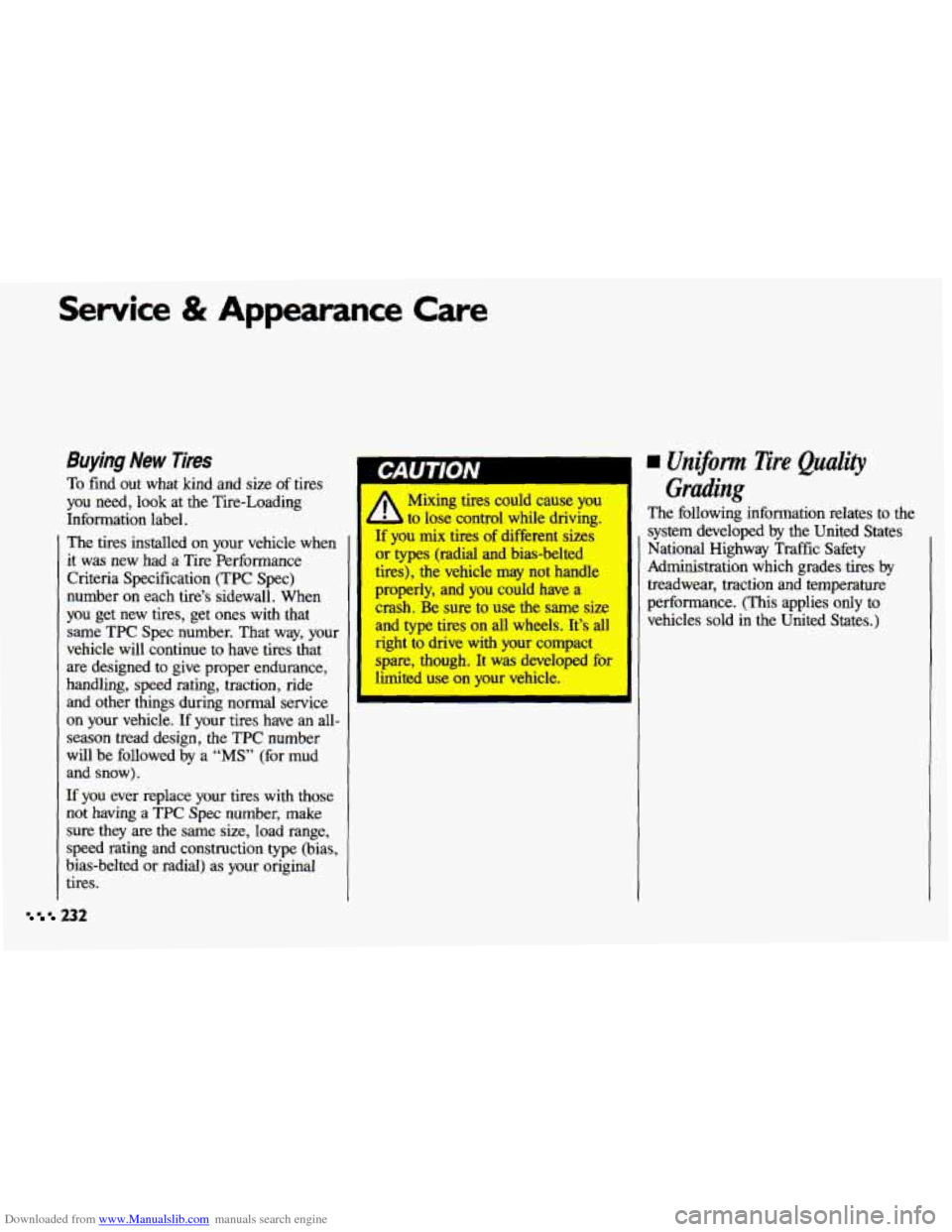
Downloaded from www.Manualslib.com manuals search engine Service & Appearance Care
Buying New Tires
To find out what kind and size of tires
you need, look at the Tire-Loading
Information label.
The tires installed on your vehicle when
it was new had a Tire Performance
Criteria Specification (TPC Spec)
number on each tire’s sidewall. When
you get new tires, get ones with that
same
TPC Spec number. That way, your
vehicle will continue to have tires that are designed to give proper endurance,
handling, speed rating, traction, ride
and other things during normal service
on your vehicle. If your tires have an all- season tread design, the TPC number
will be followed by a
“MS” (for mud
and snow).
If you ever replace your tires with those
not having a TPC Spec number, make
sure they are the same size, load range,
speed rating and construction type (bias,
bias-belted or radial) as your original
tires.
Mixing tires could cau’se you
d to lose control while driving.
If you mix tires of different sizes
or types (radial and bias-belted
tires), the vehicle
may not handle
properly,
and you could have a
crash. Be sure to use the same size
and type tires on all wheels. It’s all
right to drive with your compact
spare, though. It was developed for
limited use on your vehicle.
I I
Unijiorpn Tire Quality
Grading
The following information relates to the
system developed by the United States
National Highway Traffic Safety
Administration which grades tires by
treadwear, traction and temperature
performance. (This applies only to vehicles sold in the United States.)
232
Page 235 of 308
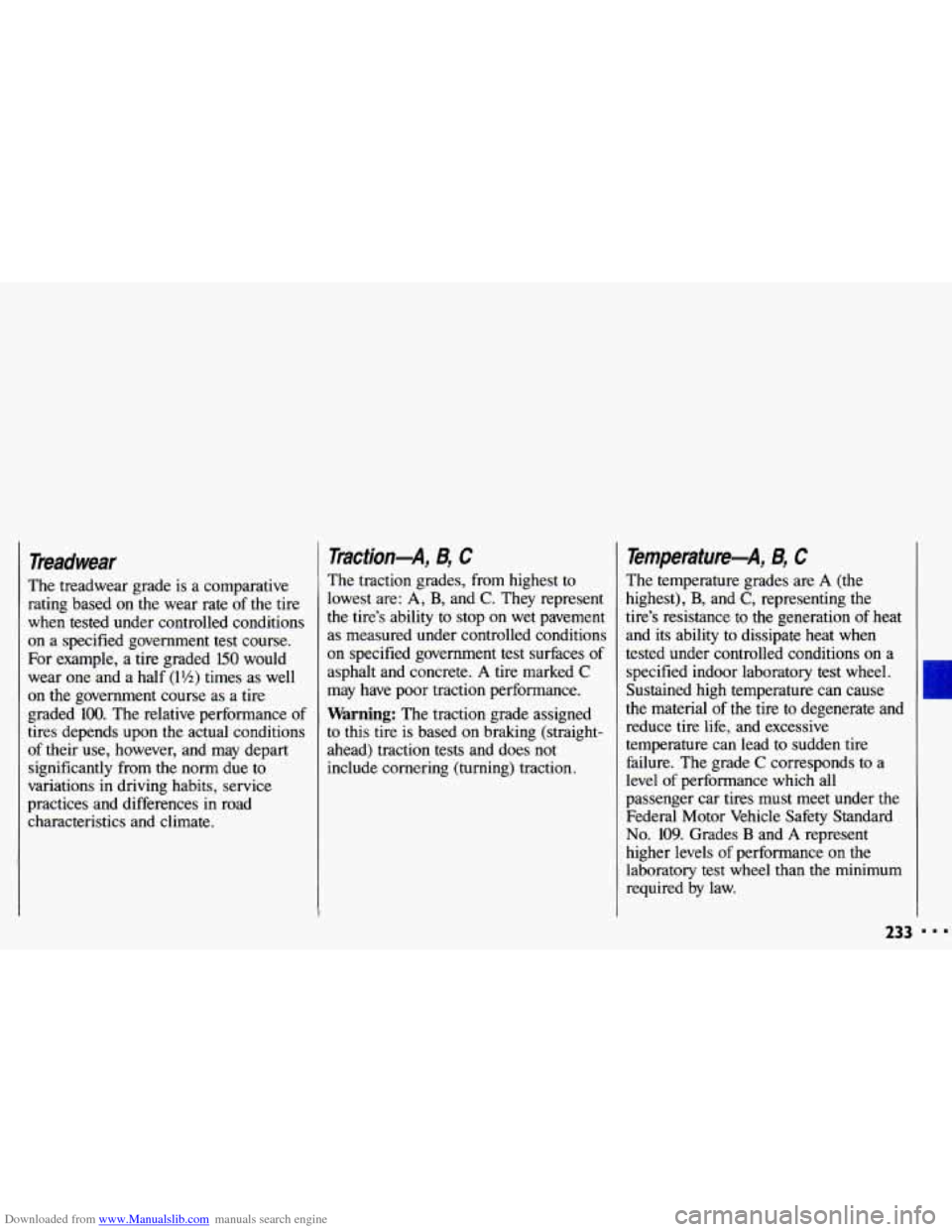
Downloaded from www.Manualslib.com manuals search engine Treadwear
The treadwear grade is a comparative
rating based on the wear rate of the tire
when tested under controlled conditions
on a specified government test course.
For example, a tire graded 150 would
wear one and a half
(1%) times as well
on the government course as a tire
graded
100. The relative performance of
tires depends upon the actual conditions
of their use, however, and may depart
significantly from the norm due to
variations in driving habits, service
practices and differences in road
characteristics and climate.
Traction-A, B, C
The traction grades, from highest to
lowest are:
A, B, and C. They represent
the tire’s ability
to stop on wet pavement
as measured under controlled conditions
on specified government test surfaces of
asphalt and concrete.
A tire marked C
may have poor traction performance.
Warning: The traction grade assigned
to this tire
is based on braking (straight-
ahead) traction tests and does
not
include cornering (turning) traction.
Temperature-A, B, C
The temperature grades are A (the
highest),
B, and C, representing the
tire’s resistance to the generation of heat
and its ability to dissipate heat when
tested under controlled conditions on a
specified indoor laboratory test wheel.
Sustained high temperature can cause
the material of the tire to degenerate and
reduce tire life, and excessive
temperature can lead
to sudden tire
failure. The grade
C corresponds to a
level of performance which all
passenger car tires must meet under the
Federal Motor Vehicle Safety Standard
No. 109. Grades B and A represent
higher levels of performance
on the
laboratory test wheel than the minimum
required
by law.
233